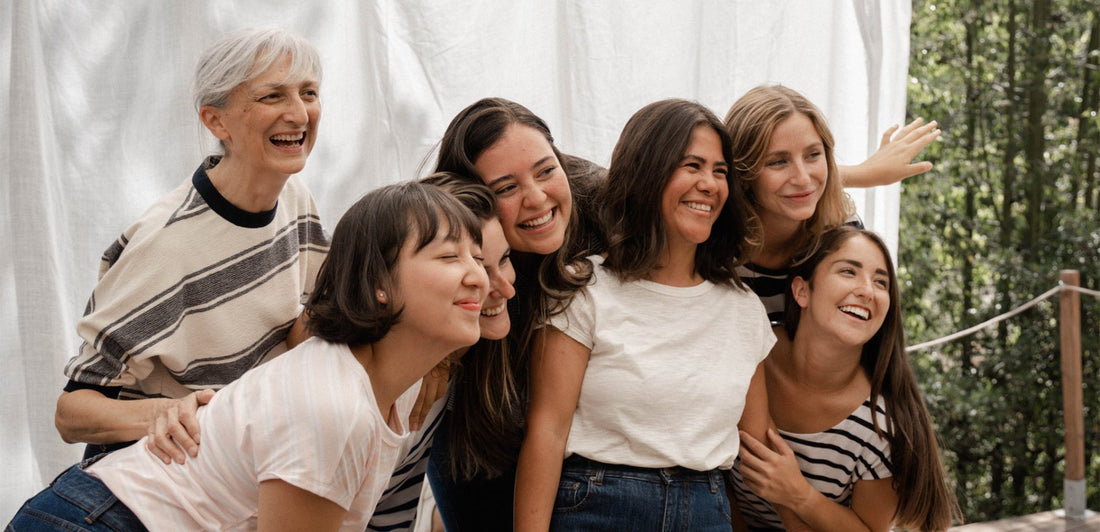They’re here! 2022’s Limited Edition styles, made from 100% deadstock fabrics. These garments are limited in number but limitless in potential. Indeed, last year’s deadstock tees were a hit with our community of eco-aware ocean lovers, who responded to the minimalist aesthetic and sustainable credentials even better than we could have hoped. For that reason, they’re back with a vengeance in a collection that features everything from deadstock dungarees to deadstock loungewear. But there’s another thing you might notice about our Limited Edition garments. To honour this very special collection and all the behind-the-scenes work involved, we decided to invite members of our own team to model the styles. Find out more about how our Limited Edition photoshoot went, later! First, let’s unroll this interesting and pretty serious-sounding fabric.
What does deadstock mean?
Landfill’s out, limited is in.
In the world of textiles, the term deadstock applies to all the leftover yards (or metres) of fabric a factory has already produced but can no longer sell. Why? Because there’s not enough of it to make a new order. For example, a leftover roll of fabric might only provide enough material to make 20 new t-shirts, which isn’t worth the time for many big brands. That “stock” is then considered “dead” and those 20 could-have-been tees are either left to gather dust on a factory shelf (a pity), or carted off to landfill (a problem). Obviously, this habit isn’t at all sustainable because all the energy and resources that have been put into the fabric are just shelved - or buried. It’s one of the unseen environmental impacts of fashion. And it happens a lot. A. Lot.
The good news is that smaller brands - like us - can pick up the slack and help out our factories when they find themselves up to their waist in waste! This gives us access to deadstock materials that we normally wouldn’t be able to use (for cost, or sustainability reasons), by designing and producing a restricted number of quality styles. Which means you’ll wear something totally unique and low impact while feeling pretty good about it.
We call our deadstock garments, “Limited Edition” and stamp each label with the number in the series - so you know how many versions of this style exist in the world, and which one is yours!
Where does deadstock come from?
Deadstock arises when:
- Brands discontinue a production line
- Factories overestimate the amount of fabric they need to meet an order
- Brands overestimate the amount of fabric they need
But hang on a minute - couldn’t brands be a little more careful with how much fabric they order? Couldn’t factories be a little more waste conscious? And couldn’t this all be made so much more efficient?
The answer is: YES. Deadstock is just one more symptom of an unsustainable fashion system that is entirely based on guesswork and speed. That’s why we spent a great deal of time setting up the pre-order system (read about the slow revolution, or watch the quick video).
Is deadstock sustainable?
Deadstock garments are sustainable because they’re made from pre-existing materials. Compared to all the energy, water and CO₂ that we’d need to make a new fabric, the impact of a deadstock fabric is… zero! As already established, it also prevents textile waste which is a huge issue in fashion.
According to Bloomberg, the US alone throws away 11.3 million tonnes of textile waste every year. The website has a pretty terrifying counter that shows how much clothing is being chucked away while you browse.
However, deadstock is not without its critics. That’s because using deadstock for garments is an antidote rather than a cure. It takes care of the collateral damage from the overproduction of textiles that shouldn’t be there in the first place.
The Challenge
Sustainability aside: making clothing from deadstock provides an interesting (we hope!) challenge for our designers and supply chain team. They need to sift through materials and patterns that already exist to make styles that ocean lovers will adore. Deadstock can be a stretch to use what’s available - but also very rewarding when it works.

As seen on our team!
It was a beautiful sunny day when we got our volunteers together to try on our new Limited Edition garments. We met on our lovely summer deck which looks out over a small forest. In the far distance, you can even see the sea.
Our ever-patient photoshoot team had handpicked a few outfits for every model - who soon decided they wanted to try all the styles until they found their favourites! And who can blame them? For this deadstock collection we’ve worked with beautiful striped fabrics, comfy cotton fleeces and thinner yarns that are great for Barcelona’s summer climate. We can now safely say these Limited Edition styles feel just as good as many TWOTHIRDS classics. Plus, they stand out for their individuality - a little like the people who were wearing them.
The team who starred in this shooting hail from countries as culturally diverse as Colombia, México, South Korea, El Salvador, Costa Rica and the UK as well as places closer to home within Catalunya or Valencia! We love this about TWOTHIRDS, as the brand has evolved into a tight-knit community of ocean lovers from all over the globe. What unites the women in this photoshoot is ultimately what differentiates them: their passions for different aspects of fashion, sustainability, and design. They make our company possible and our clothing the best it can be.
With thanks to Sonmi, Pilar, Andrea, Carolina, Paola, Emma, Gabriela and Laia, for participating in our Limited Edition photoshoot.









